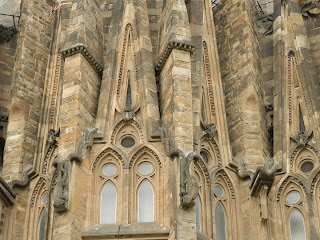Approaching the church.
An exterior shot that is of none of he facades but siding. Note the snakes and lizards slithering down the around the windows.
Passion facade from afar.
Passion facade from right below.
One of many sculptures on the passion facade depicting events in the last days of Jesus' life. This may look like lovers embracing, but it is actually Judas kissing Jesus (see the snake?). What appears to be a magic square at lower left is in fact a cryptogram invented by the architect that contains a number of combinations that add to 33, the age of Jesus at the time of the crucifixion.
Another sculpture on the passion facade. I like that he's sticking his sword into the wall.
Interior of the church. The inside is supposed to look like a forest.
Mordu demonstrating the width of the columns.
As you can see, not all the stained glass windows have been "filled in."
Another interior shot.
Interior shot looking upwards. The ceiling is meant to evoke a forest canopy.
Nativity facade.
Close-up of the nativity facade.
This is a model made by Gaudi for another church that was never built. Gaudi loved to use the catenary shape -- the natural arc of a hanging wire. If you look carefully, you will see that this model is made of lots of wires weighted by tiny sandbags so that they fall in the arcs chosen by the architect. The hanging model is up-side-down; the base of the proposed church is at the top of the frame.














Hello! I'm working on a National Geographic documentary on the Sagrada Familia and I came across your picture of the lizard gargoyle (caption: An exterior shot that is of none of he facades but siding. Note the snakes and lizards slithering down the around the windows.) I would like to know if you'll kindly allow us permission to use it.
ReplyDeleteOf course, I'll be happy to chat with you and tell you more about what we're doing should you be interested. Thanks and I look forward to hearing from you!